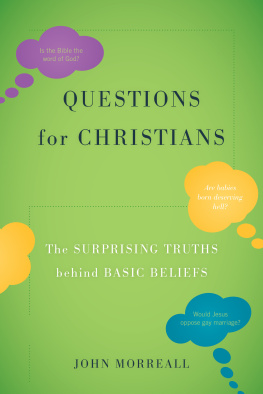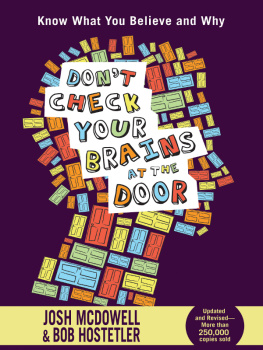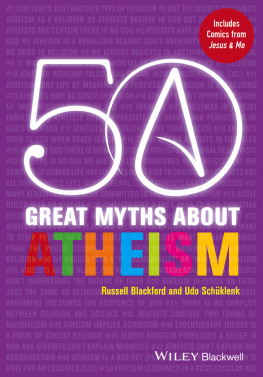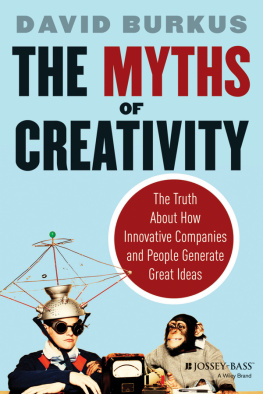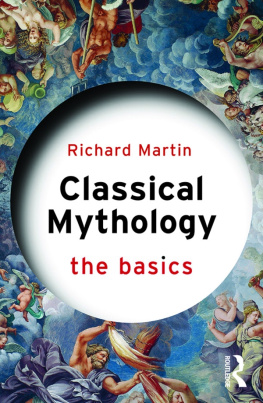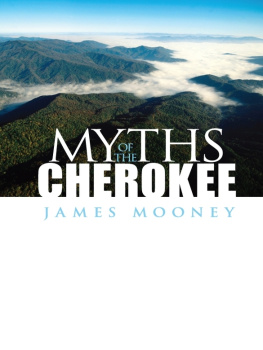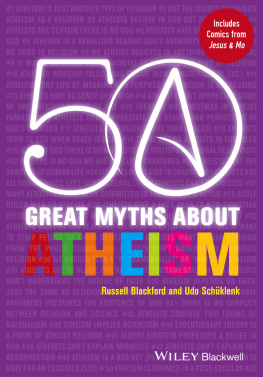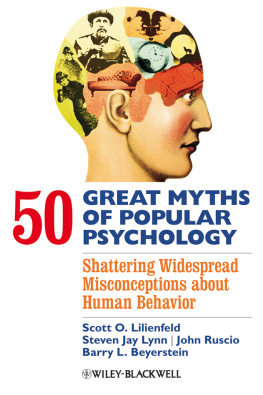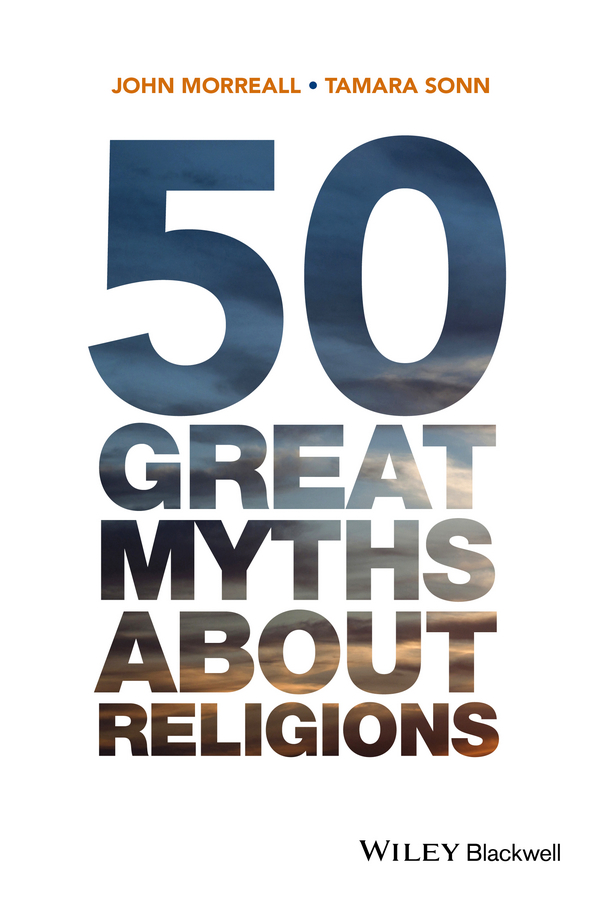
CONTENTS
Guide
Pages
50 Great Myths About Religions
John Morreall and Tamara Sonn
This edition first published 2014
2014 John Wiley & Sons, Ltd
Registered Office
John Wiley & Sons, Ltd, The Atrium, Southern Gate, Chichester, West Sussex, PO19 8SQ, UK
Editorial Offices
350 Main Street, Malden, MA 021485020, USA
9600 Garsington Road, Oxford, OX4 2DQ, UK
The Atrium, Southern Gate, Chichester, West Sussex, PO19 8SQ, UK
For details of our global editorial offices, for customer services, and for information about how to apply for permission to reuse the copyright material in this book please see our website at www.wiley.com/wiley-blackwell.
The right of John Morreall and Tamara Sonn to be identified as the authors of this work has been asserted in accordance with the UK Copyright, Designs and Patents Act 1988.
All rights reserved. No part of this publication may be reproduced, stored in a retrieval system, or transmitted, in any form or by any means, electronic, mechanical, photocopying, recording or otherwise, except as permitted by the UK Copyright, Designs and Patents Act 1988, without the prior permission of the publisher.
Wiley also publishes its books in a variety of electronic formats. Some content that appears in print may not be available in electronic books.
Designations used by companies to distinguish their products are often claimed as trademarks. All brand names and product names used in this book are trade names, service marks, trademarks or registered trademarks of their respective owners. The publisher is not associated with any product or vendor mentioned in this book.
Limit of Liability/Disclaimer of Warranty: While the publisher and authors have used their best efforts in preparing this book, they make no representations or warranties with respect to the accuracy or completeness of the contents of this book and specifically disclaim any implied warranties of merchantability or fitness for a particular purpose. It is sold on the understanding that the publisher is not engaged in rendering professional services and neither the publisher nor the author shall be liable for damages arising herefrom. If professional advice or other expert assistance is required, the services of a competent professional should be sought.
Library of Congress Cataloging-in-Publication Data applied for
Hardback ISBN: 978-0-470-67351-5
Paperback ISBN: 978-0-470-67350-8
A catalogue record for this book is available from the British Library.
Cover image: Dramatic sky omersukrugoksu/iStockphoto
Introduction : Myths and Misbelieving
Might I suggest that [people doubting religious narratives] use the tactic used by many modern Jews dealing with biblical narratives that defy credulity, from a six-day story of creation to Jonah living inside a large fish. We distinguish between left-brain narratives (meant to convey factual truth) and right-brain narratives (meant to make a point through a story; the message will be true even if the story isnt factually defensible). (Rabbi Harold Kushner (2013))
Two Meanings of Myth
This book was inspired by another Wiley Blackwell book, 50 Great Myths of Popular Psychology by Scott Lilienfeld et al. (2010), in which myth means a widespread belief that is not well supported by evidence. Some of our myths are like that, such as the beliefs that Moses wrote the first five books of the Bible, and that Jesus was born in a stable in Bethlehem on December 25. But we also count as myths common beliefs that are questionable for other reasons, such as that they conflict with the teachings of the religions of the believers. Some Muslims (and countless non-Muslims), for example, believe that the Quran promises suicide bombers 72 heavenly virgins. In the Quran, however, both suicide and terrorism are condemned as grave sins. Many Christians believe that Satan and his devils torture humans in hell, but that actually conflicts with basic Christian teachings. When we call something a myth, then, our meaning is close to the dictionary definition for misbelief: a myth is a wrong, false, or unorthodox belief or opinion, especially in religion.
There is a second meaning of myth that we should mention, because it is important in the academic field of Religious Studies. When scholars of religion talk about myths, they generally mean traditional stories that explain important aspects of life, such as where we came from, why were here, who our heroes are and what makes them special, and how we should live. A good example is the story in Genesis about Adam and Eve disobeying God by eating of the tree of the knowledge of good and evil, and then being cast out of the Garden by God. This description of the origin of evil, and stories like it, are often characterized by extraordinary and even supernatural events, and some people believe they are literally true true in the same way that a traffic report or a medical diagnosis is true. They believe the stories are accurate representations of things that really happened. But many scholars believe that such myths are not to be judged on the basis of historic or scientific accuracy. In fact, these stories generally developed before modern criteria of historical and scientific accuracy. They are often about things in the deep recesses of prehistory, and sometimes about things in the far distant future. As such, they are beyond the realms of history and science. But we cherish them anyway because they help us understand who we are and answer some of the most pressing questions in life, including why bad things happen, who can be trusted, and what might happen next.
As we listen to stories like Adam and Eve in the Garden, we sometimes get a sense that we are in touch with higher reality. We are in the realm of the transcendent, a realm beyond the frailties and limitations that characterize everyday reality. Myths of this kind are commonly transmitted in religions, so much so that many scholars include myths as essential components of religions. Another example of this kind of myth is the Creation Story in the Bible and the Quran. According to that story, a single almighty personal God created the earth and everything upon it in just a few days, and provided all that was needed for his most cherished creatures, human beings. Stories like this provide a measure of assurance that things are basically as they should be and there is a reason for us to carry on, even in the most difficult circumstances.
When viewed from this perspective, myths in religion in their own unique way can be considered true. They provide context, continuity, and comfort for the communities who share them. They are thus true for the people who believe them. The fourth-century Roman historian Sallustius spoke from this perspective when he said, Myths are things that never happened but always are (Sallustius, 1996). Joseph Campbell, among the twentieth centurys best known mythologists, called myths the womb of mankinds initiation into life and death (1969: 12). The University of Chicagos Wendy Doniger (1998) presents myths as imaginative expressions of universal human experiences, which allow us to communicate across cultures. British scholar Karen Armstrong (2005: 4) stresses the sacred aspect of myth, saying that myths speak of another plane that exists alongside our own world, and that in some sense supports it. Belief in this invisible but more powerful reality, sometimes called the world of the gods, is a basic theme of mythology. For scholars such as these, myths are very much like what Pablo Picasso said about art: a lie which makes us realize truth (Borofsy, 1923).
Next page

